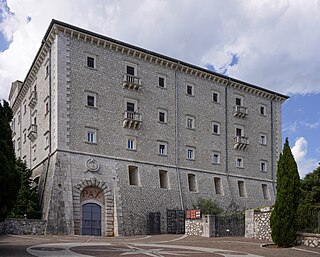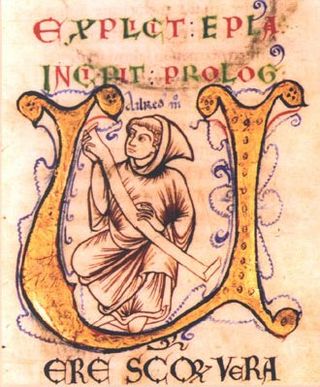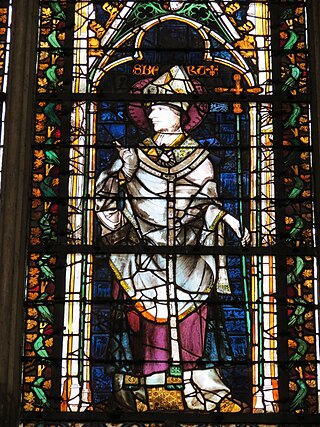Related Research Articles

Monte Cassino is a rocky hill about 130 kilometres (80 mi) southeast of Rome, in the Latin Valley, Italy, 2 kilometres west of Cassino and at an elevation of 520 m (1,710 ft). Site of the Roman town of Casinum, it is widely known for its abbey, the first house of the Benedictine Order, having been established by Benedict of Nursia himself around 529. It was for the community of Monte Cassino that the Rule of Saint Benedict was composed.

The calendar of saints is the traditional Christian method of organizing a liturgical year by associating each day with one or more saints and referring to the day as the feast day or feast of said saint. The word "feast" in this context does not mean "a large meal, typically a celebratory one", but instead "an annual religious celebration, a day dedicated to a particular saint".

Aelred of Rievaulx, O Cist., also known as also Ailred, Ælred, or Æthelred; was an English Cistercian monk and writer who served as Abbot of Rievaulx from 1147 until his death. He is venerated by the Catholic Church as a saint and by some Anglicans.

Stephen Harding was an English-born monk and abbot, who was one of the founders of the Cistercian Order. He is honored as a saint in the Catholic Church.

Robert of Molesme was an abbot, and a founder of the Cistercian Order. He is venerated as a Christian saint.

Marian hymns are Christian songs focused on Mary, mother of Jesus. They are used in both devotional and liturgical services, particularly by the Roman Catholic, Eastern Orthodox, Oriental Orthodox, Anglican, and Lutheran churches. They are often used in the month of May devotions. Some have also been adopted as Christmas hymns. Marian hymns are not popular among some Protestants, as they see Marian veneration as idolatry. However, the practice is very common among Christians of Catholic traditions, and a key component of the Eastern Orthodox liturgy. There are many more hymns to Mary within the Eastern Orthodox yearly cycle of liturgy than in Roman Catholic liturgy.

Maurus (512–584) was the first disciple of Benedict of Nursia. He is mentioned in Gregory the Great's biography of the latter as the first oblate, offered to the monastery by his noble Roman parents as a young boy to be brought up in the monastic life.

Victor the Moor was a native of Mauretania and a Christian martyr, according to tradition, and is venerated as a saint.

Saint Pantaleon, counted in Western Christianity as among the Fourteen Holy Helpers of the Late Middle Ages, and in Eastern Christianity as one of the Holy Unmercenary Healers, was a martyr of Nicomedia in Bithynia during the Diocletianic Persecution of 305 AD.

Fabius Claudius Gordianus Fulgentius, also known as Fulgentius of Ruspe, was a North African Christian prelate who served as Bishop of Ruspe in what is now Tunisia, during the 5th and 6th century. He has been venerated as a saint.

Ansbert, sometimes called Ansbert of Chaussy, was a Frankish monk, abbot and bishop of Rouen, today regarded as a saint in the Catholic Church and Eastern Orthodox Church.

Lydia of Thyatira is a woman mentioned in the New Testament who is regarded as the first documented convert to Christianity in Europe. Several Christian denominations have designated her a saint.

John the Dwarf, also called John Colobus,John Kolobos or Abba John the Dwarf, was a Coptic Desert Father of the early Christian church.
Eugendus was the fourth abbot of Condat Abbey, at Saint-Claude, Jura.

Julia of Corsica, also known as Julia of Carthage, and more rarely Julia of Nonza, was a virgin and martyr who is venerated as a saint. Her death occurred most probably in AD 439 or thereafter. She and Devota are the patron saints of Corsica in the Catholic Church. Julia was declared a patroness of Corsica by the church on 5 August 1809; Devota, on 14 March 1820. Both were martyred in pre-Christian Corsica under Roman rule. Julia's feast day is 22 May in the Western liturgical calendar and 16 July in the East.
Felix of Bourges was a bishop of Bourges who later became recognized as a saint.
Peter of Atroa (773–837) was an abbot who was later canonized as a saint.

John Theristus, OSB was an Italian Byzantine Benedictine monk. Despite dying almost a century after the Great Schism of 1054, he is notably a saint in both the Catholic and Eastern Orthodox Churches. The details of his life have been handed down by legends and popular beliefs.

Saint Peleus was an early Christian martyr. An Egyptian bishop, Peleus was one of four Christians who led Mass for the persecuted Christians condemned to work in the Palestinian quarries in the wake of the Diocletianic Persecution. When the Roman emperor Galerius learned of this, he had Peleus burned alive along with the other leaders, and the Christians dispersed to mines in Cyprus and Lebanon. He is venerated as a saint in the Roman Catholic Church, Eastern Orthodox Church and Coptic Orthodox Church.
Nilus of Palestine was an early Christian martyr. An Egyptian bishop, Nilus was one of four Christians who led Mass for the persecuted Christians condemned to work in the Palestinian quarries in the wake of the Diocletianic Persecution. When the Roman emperor Galerius learned of this, he had Nilus burned alive along with the other leaders, and the Christians dispersed to mines in Cyprus and Lebanon. He is venerated as a saint in the Roman Catholic Church, Eastern Orthodox Church and Oriental Orthodox Church.
References
- 1 2 3 4 5 6 7 8 9 "Saint Who? Saint Demetrian". Magnificat . 18 (3). Magnificat USA: 121. May 2016.
- 1 2 3 4 Butler, Alban (1995) [1756]. Butler's Lives of the Saints. Vol. 11. Collegeville, MN: Liturgical Press. p. 47. ISBN 9780860122609.
- 1 2 "Saint Demetrian of Cyprus". CatholicSaints.info. 2013. Retrieved 12 May 2016.
- 1 2 3 4 "Saint Demetrian". Catholic.org. Catholic Online. 2016. Retrieved 7 May 2016.
- 1 2 3 Walsh, Michael J. (2007). A New Dictionary of Saints: East and West. Collegeville, MN: Liturgical Press. p. 150. ISBN 9780814631867.
- ↑ Pétridès, Sophrone (1908). "Chytri". The Catholic Encyclopedia. Vol. 3. New York: Robert Appleton Company. Retrieved 12 May 2016.